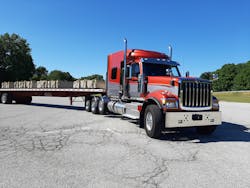International HX test drive highlights classy comfort
Walking into a garage at the Navistar Proving Grounds in northern Indiana yielded an unexpected sight: a tough-looking sleeper-cab tractor parked several lanes away. “What’s that?” I asked my hosts. “That’s what you’re driving,” one replied, then identified it as an International HX tractor, set up for heavy hauling.
I was there to drive an HX, the builder’s premium vocational model, but expected it to be a dumper or a mixer. That it was a tractor shouldn’t have surprised me, because both truck and tractor versions were listed in the introduction of the original HX about seven years before. I guess the sleeper compartment threw me off, but yes, sleepers are optional in the series.
See more: Inside the International HX
Navistar improved the HX in 2019, but the Covid 19 pandemic overshadowed the trucking industry and life in general, so the then-new model received comparatively little attention. That’s why I asked for this drive. The original HX came with a cab from the old 5000-series Paystar, but it now has a larger steel cab from the LT highway tractor. The new cab is carefully reinforced against shock from road and rough-terrain running, and though somewhat larger, weighs about the same as the old aluminum-skinned cab, said Dave Hillman, senior marketing director for vocational trucks. That allows for a more spacious feel, especially when an integrated sleeper is included. This one was a 73-inch-long, high-roof version (another sleeper option is 53 inches in length), which implied long-distance running, something I don’t associate with the carriage of stocky “yellow machines” that are what design engineers had in mind when spec’ing out this vehicle.
With a high-horsepower Cummins diesel and strong underpinnings, this tractor was rated at 150,000 pounds gross combination weight, almost twice the 80,000 pounds maximum that an 18-wheel freight hauler can carry in the U.S. When hooked to a 53-foot flatbed, our test rig actually had 20 wheels, though the tractor’s pusher-type lift axle wasn’t needed because the concrete blocks aboard the trailer weighed but 42,000 pounds, for a CGW in the low 70,000-pound range. But that was enough to evaluate the HX’s behavior. The big Cummins X15 ran through an Eaton UltraShift Plus automated manual transmission that did most of the work, so driving was a relaxing experience. In spite of a forward-set steer axle, the tractor’s turning radius was agreeably tight and what maneuvering I did required little thinking.
I liked the HX’s blocky yet smooth styling, its big nose and chrome-and-black grille evoking memories of the classy tractors of the past, or of competitors’ current models purposely styled to favor tradition. This prompted me to ask if the HX might be offered as a lighter-duty highway tractor to capture some of that business from “old school” truckers, but the answer from Hillman was a firm "No": This would remain a Heavy Extreme model as its name indicates (besides, International’s 1930s art deco-styled Lone Star serves that premium market).
Test track manners
The HX’s driving manners were decidedly smooth, whether on or off pavement. The proving grounds, originally built by Studebaker in 1926, contain a variety of roads and trails, from a 3-mile asphalt track to gravel paths and rough, undulating surfaces meant to test a truck’s mettle by shaking its metal, rubber, glass, and everything else half to death.
However, this tractor was not meant to die but to shine while showing off its capabilities to potential customers, so Hillman asked me to stay on the comparatively docile gravel trails. Ride was good for a vocational truck with stiff suspensions no matter where we traveled. Good sound insulation in the updated cab allowed us to converse in normal tones, and interior appointments were top notch. The woodsy trail we were on ended with a short but steep downgrade leading toward the large track; on the grade I switched on the X15’s Intebrake by manipulating the multifunction switch on a stalk mounted on the steering column. The retarder has four positions, from Off to 1, 2, and 3, with braking force increasing as I pulled the stalk downward. The retarder was strong, and I descended the hills without needing service brakes. A collar on the stalk had three main settings for the transmission: R, N, and D, plus an M position from which manual ratio changing could be done. I just left it in Drive and let the UltraShift competently shift itself. The steering wheel’s rim and spokes sometimes hid the stalk from view but I got used to it.
The Cummins X15’s 605 horsepower and 1,850 lb.-ft. of torque were way more than adequate during my limited driving experience with the moderate load on mostly flat terrain. Along with the strong compression brake, this engine should suit most drivers even in hilly or mountainous terrain. It has to, because it’s the largest engine available in the long-nose, 520-series HX (though Navistar also offers a 2,050-lb.-ft. version and Cummins publishes a 675-horsepower rating for off-highway applications). A slightly shorter HX-620 comes with Navistar’s own A26 with up to 515 horsepower (and this time next year, it’ll be standard with a just-announced Swedish-inspired S13 diesel). Navistar and other truck builders argue that a 13-liter-class diesel is more than powerful enough to handle most normal assignments. But with heavier loads and higher expectations, both for performance and longevity, the X15 will deliver more driver satisfaction and probably longer life to overhaul. Smaller diesels can now live almost as long and save some fuel, but as the saying goes, there’s no replacement for displacement.
Aside from what’s in the engine compartment, atop the HX’s hood was a feature I found attractive and useful: the triangular bulge streaming back from the International diamond logo on the nose. Hillman called it a "wind split." It looks neat and probably adds a bit of stiffness to the composite material used in the hood. And it serves as an aiming point; keep it on the right edge of a road surface and the rig’s wheels will stay off the shoulder. This complements excellent outward visibility from inside the HX’s cab, due to big windows and good mirrors. The latter included the hood-mounted pod-type mirrors that, due to old habits, I seldom used on this truck or any other I’ve driven. I did note that their housings are chrome-plated, nicely tying in with the copious amount of bright-metal trim and polished aluminum cabinets and fenders that punctuated the two-tone paint and fine lines of this handsome tractor. Good thing I wore sunglasses.
International HX Test Drive Specifications
Truck: International HX-520, 6x4 heavy-haul tractor, forward-set steer axle, w/ 12.25x 3.38x0.375-in. frame rails, BBC 120 in., GVW 76,320 lb., GCW 150,000 lb.
Engine: Cummins X15 Productivity; 14.9L (910-cu.-in.); 605 hp @ 2,000 rpm; 1,850 lb-ft. @ 1,000 rpm; w/ Jacobs Intebrake retarder and Horton 2-speed fan drive
Transmission: Eaton Fuller FO-20E318B-MXP UltraShift+ automated 18-speed overdrive
Tires: Steer, 315/80R22.5 Goodyear G751; rear, 11R22.5 Continental HSR2; lift, 295/75R22.5 Continental HSR3
Wheels: Alcoa polished aluminum discs
Front axle: 16,000-lb. Meritor MFS-16-135A, on parabolic leaf springs, w/ Bendix Spicer air disc brakes
Lift axle: 20,000-lb. Watson & Chalin SL-2065 Tru-Track self-steering, on air springs, w/ S-cam drum brakes
Rear axles: 46,000-lb. Meritor RT-46-164P w/ 4.10 ratio differentials and Bendix Spicer air disc brakes, on Hendrickson Primaax EX air-spring suspension
Wheelbase: 289 in.
Fuel tanks: two 80-gal. aluminum
DEF tank: 15.9-gal. plastic
About the Author

Tom Berg
Tom Berg is widely acknowleged as one of the top truck writers in the industry. He has covered construction for more than 34 years, and has test-driven well over 150 trucks for Construction Equipment.
